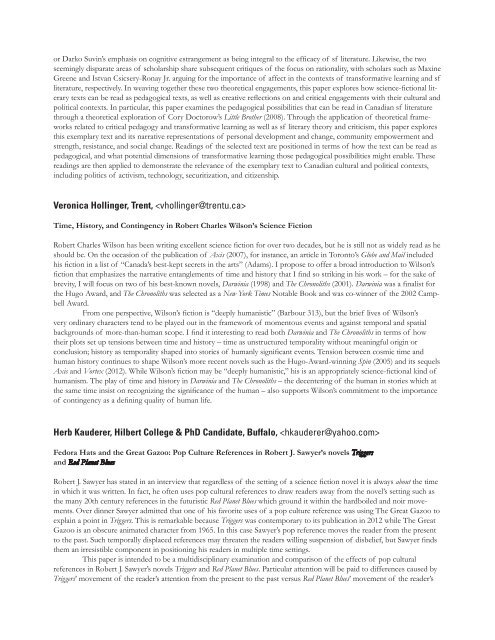SCIENCE FICTION - Author Robert J. Sawyer
SCIENCE FICTION - Author Robert J. Sawyer
SCIENCE FICTION - Author Robert J. Sawyer
Create successful ePaper yourself
Turn your PDF publications into a flip-book with our unique Google optimized e-Paper software.
or Darko Suvin’s emphasis on cognitive estrangement as being integral to the efficacy of sf literature. Likewise, the twoseemingly disparate areas of scholarship share subsequent critiques of the focus on rationality, with scholars such as MaxineGreene and Istvan Csicsery-Ronay Jr. arguing for the importance of affect in the contexts of transformative learning and sfliterature, respectively. In weaving together these two theoretical engagements, this paper explores how science-fictional literarytexts can be read as pedagogical texts, as well as creative reflections on and critical engagements with their cultural andpolitical contexts. In particular, this paper examines the pedagogical possibilities that can be read in Canadian sf literaturethrough a theoretical exploration of Cory Doctorow’s Little Brother (2008). Through the application of theoretical frameworksrelated to critical pedagogy and transformative learning as well as sf literary theory and criticism, this paper exploresthis exemplary text and its narrative representations of personal development and change, community empowerment andstrength, resistance, and social change. Readings of the selected text are positioned in terms of how the text can be read aspedagogical, and what potential dimensions of transformative learning those pedagogical possibilities might enable. Thesereadings are then applied to demonstrate the relevance of the exemplary text to Canadian cultural and political contexts,including politics of activism, technology, securitization, and citizenship.Veronica Hollinger, Trent, Time, History, and Contingency in <strong>Robert</strong> Charles Wilson’s Science Fiction<strong>Robert</strong> Charles Wilson has been writing excellent science fiction for over two decades, but he is still not as widely read as heshould be. On the occasion of the publication of Axis (2007), for instance, an article in Toronto’s Globe and Mail includedhis fiction in a list of “Canada’s best-kept secrets in the arts” (Adams). I propose to offer a broad introduction to Wilson’sfiction that emphasizes the narrative entanglements of time and history that I find so striking in his work – for the sake ofbrevity, I will focus on two of his best-known novels, Darwinia (1998) and The Chronoliths (2001). Darwinia was a finalist forthe Hugo Award, and The Chronoliths was selected as a New York Times Notable Book and was co-winner of the 2002 CampbellAward.From one perspective, Wilson’s fiction is “deeply humanistic” (Barbour 313), but the brief lives of Wilson’svery ordinary characters tend to be played out in the framework of momentous events and against temporal and spatialbackgrounds of more-than-human scope. I find it interesting to read both Darwinia and The Chronoliths in terms of howtheir plots set up tensions between time and history – time as unstructured temporality without meaningful origin orconclusion; history as temporality shaped into stories of humanly significant events. Tension between cosmic time andhuman history continues to shape Wilson’s more recent novels such as the Hugo-Award-winning Spin (2005) and its sequelsAxis and Vortex (2012). While Wilson’s fiction may be “deeply humanistic,” his is an appropriately science-fictional kind ofhumanism. The play of time and history in Darwinia and The Chronoliths – the decentering of the human in stories which atthe same time insist on recognizing the significance of the human – also supports Wilson’s commitment to the importanceof contingency as a defining quality of human life.Herb Kauderer, Hilbert College & PhD Candidate, Buffalo, Fedora Hats and the Great Gazoo: Pop Culture References in <strong>Robert</strong> J. <strong>Sawyer</strong>’s novels Triggersand Red Planet Blues<strong>Robert</strong> J. <strong>Sawyer</strong> has stated in an interview that regardless of the setting of a science fiction novel it is always about the timein which it was written. In fact, he often uses pop cultural references to draw readers away from the novel’s setting such asthe many 20th century references in the futuristic Red Planet Blues which ground it within the hardboiled and noir movements.Over dinner <strong>Sawyer</strong> admitted that one of his favorite uses of a pop culture reference was using The Great Gazoo toexplain a point in Triggers. This is remarkable because Triggers was contemporary to its publication in 2012 while The GreatGazoo is an obscure animated character from 1965. In this case <strong>Sawyer</strong>’s pop reference moves the reader from the presentto the past. Such temporally displaced references may threaten the readers willing suspension of disbelief, but <strong>Sawyer</strong> findsthem an irresistible component in positioning his readers in multiple time settings.This paper is intended to be a multidisciplinary examination and comparison of the effects of pop culturalreferences in <strong>Robert</strong> J. <strong>Sawyer</strong>’s novels Triggers and Red Planet Blues. Particular attention will be paid to differences caused byTriggers’ movement of the reader’s attention from the present to the past versus Red Planet Blues’ movement of the reader’s


